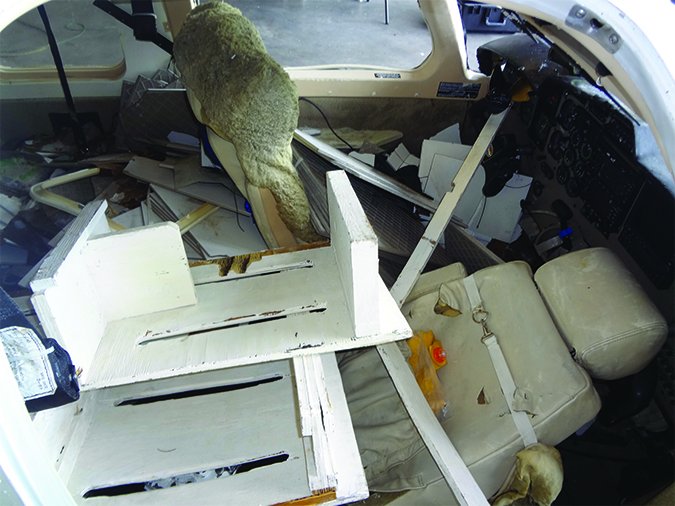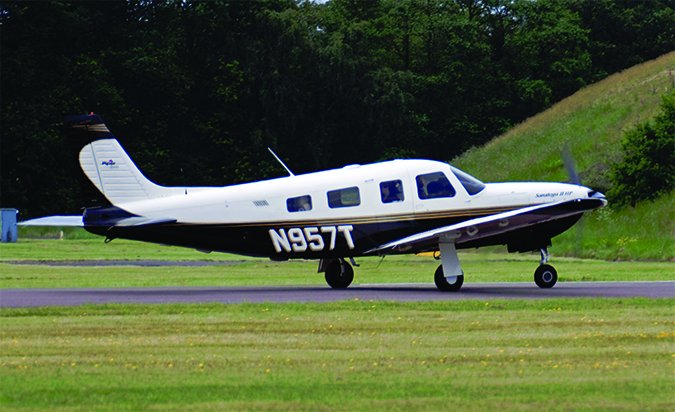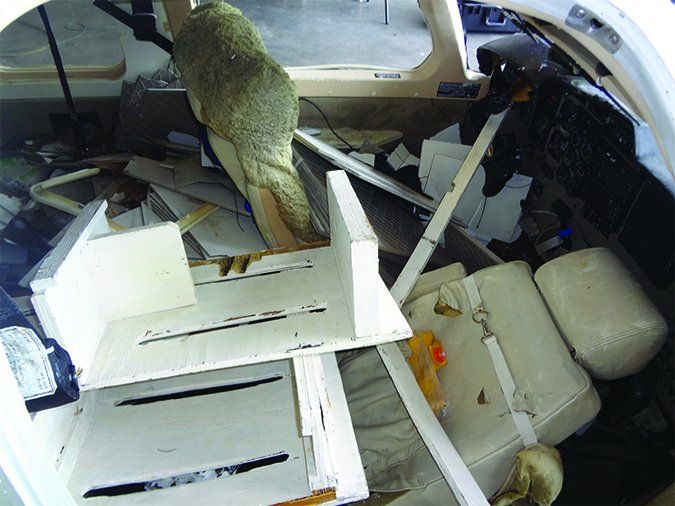One of the things primary students learn early during their ground-school training—perhaps before they ever get into an airplane—is that the items loaded into it can weigh no more than a certain amount, and have to go in certain places. Overloading the aircraft, and/or placing heavy items far from its nominal center of gravity, is bad, they’re told. Somewhere along the way, it might also be explained that those items need to be secured.
But the common way we load airplanes—especially those in which the passenger cabin and the cockpit are the same space—is to throw some soft-sided luggage in the baggage compartment, maybe throw some heavy things in the back seats or the floorboard behind the front seats, and light the fires. Little thought usually is given to whether those items should be secured, or how. That’s in sharp contrast to how we treat the passengers.
Sure—part of the reason we strap down passengers is to prevent their injury. We have seat belts and shoulder harness for all that, and we’re required to wear them at certain times. But we rarely have a cargo net of appropriate size and strength, or can easily determine where tiedown straps should be anchored.
I received a very good lesson in securing items about the cabin some years ago when I was checking out in an A36 Bonanza. During a stall recovery, I shoved the nose over with a bit too much enthusiasm. I had all my gear and charts in a largish briefcase behind the seats. During my stall “recovery,” the briefcase ended up against the aft bulkhead, with its contents everywhere.
Practice stalls notwithstanding, pilots rarely plan on a ride bumpy enough to dislodge luggage or other items, and even if they shift position in flight, what’s the worst that could happen? Pretty much this.
Background

On July 16, 2014, at about 1745 Eastern time, a Piper PA-32R-301T Saratoga II TC was substantially damaged when it impacted the water near North Captiva Island, Fla. The solo private pilot was fatally injured. Visual conditions prevailed.
Numerous witnesses reported the airplane appeared to be departing the privately owned turf runway and “was having a hard time trying to climb.” Another witness reported the pilot had flown in earlier in the afternoon with a load of tile and the accident flight was the second such trip of the day. Another eyewitness reported the airplane appeared to be recovering from “an aborted landing and did not have the airspeed to recover.”
The airplane was located in eight to 10 feet of water, approximately 200 yards west-southwest of the 1800-foot-long turf runway, which was oriented east/west. During its recovery, the right wing was damaged; the stabilator and left wing could not be located with sonar or a visual search. Witness statements indicate the airplane impacted the water in a left-wing-low attitude.
Loose Items
The NTSB said it could not determine how the unsecured tiles were loaded before the accident. The photo at right was taken after the fuselage was recovered from the Gulf of Mexico and transported to a hangar. Post-accident weight-and-balance calculations were performed for several distribution scenarios. The calculations revealed that many of them would have resulted in a gross weight and CG within the envelope limits. With the tiles loaded in the aft cargo position, however, the airplane’s aft-CG limits could have been exceeded by as much as four inches.
The NTSB believes it’s likely the unsecured tiles began to slide forward during the landing attempt, altering the CG and maybe leading the pilot to go around. But when he applied power and pitched the nose up, the unsecured tiles slid aft, exceeding the aft CG limit and pitching up the nose even further. This resulted in the airplane exceeding its critical angle-of-attack, an aerodynamic stall and collision with the water.
Investigation
The landing gear lever was in the down position and the gear switch was bent to the right. The flap handle was in the 40-degree, or full-down position. The right main landing gear was impact-separated at its attach point; its hydraulic extension ram was extended eight inches, correlating to it being down and locked at the time of impact. The flap jackscrew was measured at three exposed threads, correlating to the wing flaps being fully extended to the 40-degree position.
Both magnetos were on, and the engine controls—throttle, mixture and prop—were in their full-forward, maximum power positions. The three-blade propeller exhibited S-bending and tip curling on all blades, which were bent aft at between 17 and 19 inches from the propeller hub. The fuel selector valve and its indicator both showed the right fuel tank was selected. The right wing’s fuel cap was tight and secure and no water was present in the fuel when drained to facilitate recovery. It contained 15 gallons of liquid similar in color and smell as 100LL.
The 1745 weather observed approximately 20 miles east of the accident location included wind from 330 degrees at 19 knots, gusting to 30 knots, visibility 1 miles, thunderstorms in the vicinity and light rain. There were scattered clouds at 2400 feet agl, with a broken layer at 3400 feet. The observation’s remarks section reported lightning in all quadrants surrounding the airport.
The airplane had only two front seats; the four aft passenger seats had been removed sometime prior to the accident flight. Both remaining seats remained on their respective seat tracks and locked in place. The two front seatbelts were unlatched when found.
Porcelain tiles and two wooden pallets were located, unsecured in the cabin section of the airplane. The tiles and pallets were removed and weighed, on a scale; the contents weighed a total of 666 pounds. A placard located on the aft wall of the cargo compartment indicated that 609 pounds was the maximum allowed cargo weight. No cargo securing mechanism was noted in the accident aircraft other than the passenger seatbelts and a single cargo strap that were found folded and stowed inside the aircraft.

Probable Cause
The NTSB determined the probable cause(s) of this accident to include: “The pilot’s failure to secure the cargo in the cargo compartment, which resulted in a weight shift that led to the center of gravity exceeding its aft limit during a go-around attempt and a subsequent aerodynamic stall. Also causal to the accident were the pilot’s inadequate preflight inspection and his loading the airplane beyond the cargo compartment weight limit.”
It’s pretty clear the pilot was attempting a go-around. What’s not clear is why. It’s also not clear why the gear and flaps hadn’t been retracted. With thunderstorms in the area, conditions at the relatively short turf runway may have changed since the pilot flew away from it earlier in the day. A shift in wind velocity while on short final could have been the initiating event; turbulence also may have contributed to shifting the tile around.
It’s not unusual to use a personal airplane to carry outsized items to otherwise inaccessible places; that’s one of the things they’re good for. But we rarely secure luggage and other loose items so they don’t shift position in flight. We just don’t think about it, even though we should.
AIRCRAFT PROFILE: Piper PA-32R-301T Saratoga II TC
Engine: Lycoming TIO-540-AH1A
Empty weight: 2464 lbs.
Max gross TO weight: 3600 lbs.
Typical cruise speed: 170 KTAS
Standard fuel capacity: 102 gal.
Service ceiling: 20,000 ft.
Range: 822 nm
Vso: 60 KIAS




